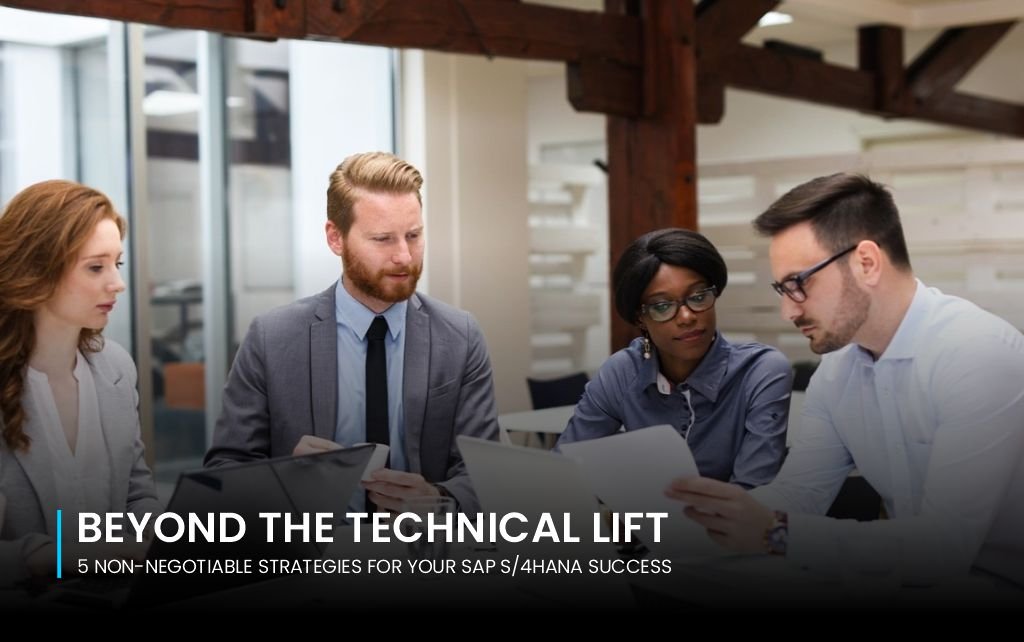The decision to migrate to SAP S/4HANA is more than a routine IT upgrade; it’s a commitment to future-proofing your entire enterprise. It’s the digital core that promises unparalleled agility, real-time insights, and streamlined processes. Yet, industry whispers and sobering reports often tell a tale of budgets ballooning, timelines stretching, and promised value seeming just out of reach.
Why does this happen? The common denominator in challenging implementations is rarely a failure of technology. SAP S/4HANA is a robust and powerful system. The stumbling blocks are almost always human and strategic.
After examining numerous successful deployments, a clear pattern emerges. Victory isn’t claimed by those with the biggest budget alone, but by those who approach the project as a holistic business transformation. Here are the five non-negotiable strategies that separate triumphant S/4HANA projects from the rest.
1. The Cornerstone: Secure Unwavering Executive Sponsorship & Cross-Functional Alignment
Many organizations make a critical error from the outset: they label S/4HANA as an “IT project.” This immediately relegates it to a technical exercise, siloing responsibility and starving it of the business-wide engagement it requires.
Why It’s a Game-Changer:
True executive sponsorship goes far beyond signing a cheque. An active, visible C-suite champion does three vital things:
- Legitimizes the Change: They communicate the “why” relentlessly, connecting the new system to the company’s overarching strategic goals—be it global expansion, superior customer experience, or data-driven innovation.
- Breaks Down Silos: They have the authority to mandate collaboration between department heads in Finance, Supply Chain, Sales, and Operations, ensuring the solution is designed for integrated business outcomes, not just IT requirements.
- Maintains Momentum: During inevitable challenges, a strong sponsor helps navigate obstacles, secure resources, and keep the project on track and prioritized.
How to Implement It:
- Form a Governance Council: Establish a steering committee led by a C-level executive (ideally the CEO or CFO) and including VPs from every major business unit.
- Define KPIs Together: This council must jointly define what success looks like using business metrics (e.g., reduced days sales outstanding, improved inventory turnover), not just technical go-live dates.
- Communicate Relentlessly: The sponsor should be a constant voice in company-wide updates, celebrating milestones and being transparent about the journey.
Without this top-down, business-led drive, the project lacks the oxygen it needs to survive.
2. The Architectural Mandate: Embrace the “Clean Core” Philosophy
For decades, SAP implementations were synonymous with heavy customization. Businesses would bend the ERP system to their unique, and often outdated, processes, creating a complex web of custom code. With S/4HANA, this approach is a recipe for high costs and strategic paralysis.
Why It’s a Game-Changer:
A “Clean Core” means maximizing the use of SAP’s standard processes and minimizing deep customization. This isn’t about forcing your business into a rigid box; it’s about leveraging SAP’s decades of best-practice research embedded within S/4HANA. The benefits are profound:
- Simplified Upgrades: A system with minimal custom code can be upgraded faster, cheaper, and with far less risk.
- Agility and Innovation: A clean core allows you to rapidly adopt new SAP innovations like AI, machine learning, and advanced analytics as they are released.
- Reduced TCO: You spend less on development, testing, and maintenance of custom code over the system’s entire lifecycle.
How to Implement It:
- Process Re-engineering First: Before coding anything, ask: “Can we adopt the standard process?” Often, the standard is a better way of working.
- Extend on SAP Business Technology Platform (BTP): For necessary unique differentiators, use SAP BTP to build side-by-side extensions. This keeps your core clean while allowing for limitless innovation.
- Conduct a Brownfield Analysis: If migrating from ECC, use tools like the SAP Readiness Check to identify custom code and start planning its retirement or migration to BTP.
Adopting this philosophy is a strategic shift from “how we’ve always done it” to “how we can do it best.”
- The Foundation of Truth: Execute a Meticulous Data Migration & Cleansing Strategy
S/4HANA is an in-memory database that processes transactions and analytics in real-time. This power is utterly wasted if the data flowing into it is flawed. The old adage “garbage in, garbage out” has never been more relevant.
Why It’s a Game-Changer:
Data migration is not a final pre-go-live task; it is a project in itself that must run in parallel from day one. Poor data quality leads to catastrophic reporting errors, operational mistakes, and, most damagingly, a complete loss of user trust in the new system from the very first day.
How to Implement It:
- Start Early, Cleanse at the Source: Begin profiling and cleansing data in your legacy systems months before migration. Fixing data at its origin is more effective and less disruptive.
- Governance is Key: Appoint data owners from the business units. They are the only ones who can truly validate what “correct” data looks like for their domain (e.g., a master data manager for materials).
- Mock Migrations: Conduct multiple dry runs. Test the extraction, transformation, and loading (ETL) processes repeatedly to identify issues, validate data quality, and fine-tune timing.
Treating your data with the respect it deserves ensures that your shiny new S/4HANA system is built on a foundation of rock, not sand.
- The Human Factor: Prioritize Change Management & User Adoption
You can have a flawlessly designed system on a pristine core with perfectly clean data, and the project can still fail. How? If the people who need to use it every day reject it.
Why It’s a Game-Changer:
Technical go-live is the beginning of the value realization journey, not the end. Value is only delivered when users efficiently adopt the new processes and tools. Change management mitigates the natural human resistance to change by focusing on communication, training, and support, turning potential adversaries into active advocates.
How to Implement It:
- Segment Your Audience: A warehouse forklift operator needs different training than a financial analyst. Tailor communications and training programs to specific user roles.
- Engage Change Champions: Identify influential and positive end-users from each department early on. Involve them in testing, train them first, and let them become the voice of the project among their peers.
- Provide Contextual Support: Move beyond generic manuals. Offer role-based training, hyper-care support immediately after go-live, and digital adoption platforms (DAPs) that provide embedded, in-process guidance.
Investing in people is investing in the return on your S/4HANA investment.
- The Delivery Blueprint: Leverage an Agile, Phased Methodology
The “Big Bang” approach—flipping the switch on everything, everywhere, all at once—is the riskiest strategy imaginable for a transformation of this scale. Modern successful projects embrace agility and phasing.
Why It’s a Game-Changer:
An Agile methodology with a phased rollout de-risks the project significantly. It allows you to:
- Learn and Adapt: Lessons learned from the first phase can be applied to subsequent waves, improving efficiency and outcomes each time.
- Deliver Value Faster: You can go live with a specific business unit or region and start realizing benefits long before the entire global project is complete.
- Manage Business Disruption: A controlled, phased approach is less overwhelming for the organization and allows the support team to focus its energy more effectively.
How to Implement It:
- Choose a Logical Phasing: This could be by geographic region (e.g., Americas first), business unit (e.g., Finance first), or product line.
- Adopt Agile Sprints: Break the work for each phase into short, iterative sprints with defined goals. This creates a rhythm of continuous design, build, test, and feedback cycles.
- Build a Minimum Viable Product (MVP): Focus on delivering core, high-value functionality in the first phase, rather than getting bogged down trying to configure every possible scenario on day one.
This iterative, pragmatic approach builds confidence, manages risk, and creates a series of wins that fuel long-term success.
Conclusion: A Journey of Transformation
Implementing SAP S/4HANA is a marathon, not a sprint. It is a journey that will test your organization’s resolve, collaboration, and strategic vision. By moving beyond a purely technical focus and embracing these five proven strategies—strong leadership, a clean core, pristine data, passionate users, and a smart rollout—you do more than just install new software.
You lay the groundwork for a more intelligent, agile, and resilient enterprise, fully prepared to thrive in the digital economy. The goal is not just a successful go-live; it’s a successful business future.





